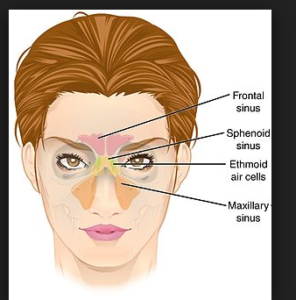The sinuses are hollow areas in the bones of the face. When the lining becomes infected, extra mucus is produced causing a stuffy nose, pain in the face and yellow or green discharge. The condition is often referred to as rhinosinusitis as both the nose and sinuses are affected.
What causes sinusitis?
Viruses associated with the common cold cause the vast majority of cases. Bacterial infection may later develop in an inflamed sinus cavity. While viral sinusitis is treated with supportive care, antibiotics may be needed to treat bacterial disease.
Is sinusitis common?
Yes. It is really common. 12-15% of adults are affected annually.
How do I know if my symptoms are viral or bacterial?
Mild symptoms generally suggest viral illness
- mild pain, symptoms for less than 7 days, temperature less than 101F.
Severe symptoms are more suggestive of bacterial infection
- severe pain more than 3-4 days
- persistent pain more than 10 days
- worsening of symptoms despite supportive care
- “double -sickening” — initial improvement followed by worsening of symptoms
- fever greater than 102F.
How is sinusitis treated ?
Mild disease is treated with supportive care:
- over the counter analgesics such as acetaminophen (Tylenol) or ibuprofen (Advil, Motrin)
- saline irrigation (Ocean spray, netty pot with sterile or distilled water)
- intranasal corticosteroids (Flonase, Nasonex)
- oral decongestants such as pseudephedrine (Sudafed), but these are limited to patients without heart disease, high blood pressure or closed angle glaucoma
- topical intranasal decongestants such as oxymetazoline (Afrin), but limited to less < 4 days)
Severe sinus disease is treated with antibiotics in addition to supportive care. It is important to continue with supportive care even after starting antibiotics to more quickly and effectively clear the infection.
Antibiotic Choices
- Augmentin (amoxicillin- clavulanate) for 5-7 days is the drug of choice.
- Penicillin-allergic patienta may be treated with doxycycline or a quinolone such as moxifloxacin or levofloxacin.
- Azithromycin (Zpak) is generally not a good option because of the relatively high rate of resistance of the bacteria Streptococcus pneumonia, a very common cause of bacterial rhinosinusitis.
Summary
Sinusitis congestion is really common and is largely caused by rhinoviruses, which are not affected by antibiotics. Supportive measures are usually sufficient to keep you comfortable for the 7-10 day total course of the illness. More severe or longer duration sinusitis symptoms suggest bacterial infection, where antibiotics are indicated. The popular Zpak is rarely the right choice.


